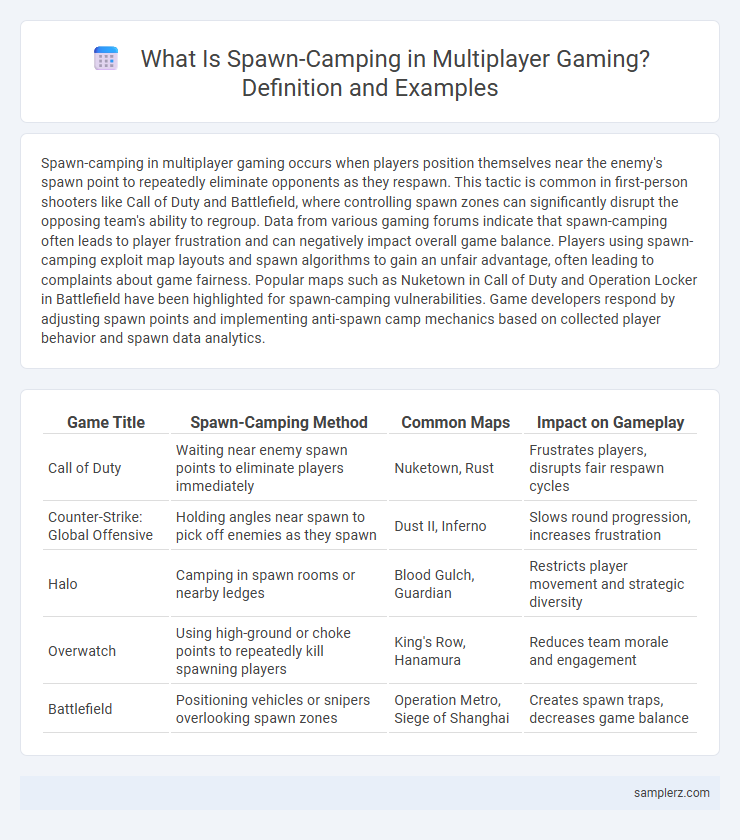Spawn-camping in multiplayer gaming occurs when players position themselves near the enemy's spawn point to repeatedly eliminate opponents as they respawn. This tactic is common in first-person shooters like Call of Duty and Battlefield, where controlling spawn zones can significantly disrupt the opposing team's ability to regroup. Data from various gaming forums indicate that spawn-camping often leads to player frustration and can negatively impact overall game balance. Players using spawn-camping exploit map layouts and spawn algorithms to gain an unfair advantage, often leading to complaints about game fairness. Popular maps such as Nuketown in Call of Duty and Operation Locker in Battlefield have been highlighted for spawn-camping vulnerabilities. Game developers respond by adjusting spawn points and implementing anti-spawn camp mechanics based on collected player behavior and spawn data analytics.
Table of Comparison
| Game Title | Spawn-Camping Method | Common Maps | Impact on Gameplay |
|---|---|---|---|
| Call of Duty | Waiting near enemy spawn points to eliminate players immediately | Nuketown, Rust | Frustrates players, disrupts fair respawn cycles |
| Counter-Strike: Global Offensive | Holding angles near spawn to pick off enemies as they spawn | Dust II, Inferno | Slows round progression, increases frustration |
| Halo | Camping in spawn rooms or nearby ledges | Blood Gulch, Guardian | Restricts player movement and strategic diversity |
| Overwatch | Using high-ground or choke points to repeatedly kill spawning players | King's Row, Hanamura | Reduces team morale and engagement |
| Battlefield | Positioning vehicles or snipers overlooking spawn zones | Operation Metro, Siege of Shanghai | Creates spawn traps, decreases game balance |
Defining Spawn-Camping in Multiplayer Games
Spawn-camping in multiplayer games refers to players strategically positioning themselves near enemy spawn points to repeatedly eliminate opponents as they respawn. This tactic disrupts fair gameplay by limiting the opposing team's ability to regroup and respond effectively. Common in tactical shooters like Call of Duty and Counter-Strike, spawn-camping is often seen as a frustrating and controversial strategy among gamers.
Notorious Spawn-Camping Incidents in FPS Titles
Notorious spawn-camping incidents in FPS titles include the infamous "Dust 2" map in Counter-Strike, where players exploited limited spawn points to trap opponents immediately after respawning. Call of Duty's "Rust" map is also well-known for aggressive spawn-camping, leading to widespread frustration and heated debates within the community. These instances highlight the balance challenges developers face in designing fair respawn mechanics and map layouts in multiplayer games.
Spawn-Camping Tactics in Team-Based Shooters
Spawn-camping tactics in team-based shooters involve players positioning themselves near the enemy's spawn point to quickly eliminate opponents as they respawn, disrupting their ability to regroup or strategize. Common examples include hiding behind cover spots like crates or walls within the spawn zone in games like Call of Duty and Overwatch. Effective spawn-camping requires map control, awareness of enemy spawn rotations, and communication to trap and eliminate respawning players efficiently.
Popular Maps Known for Spawn-Camping Issues
Popular multiplayer maps such as Dust II in Counter-Strike: Global Offensive and Nuketown in Call of Duty are frequently cited for spawn-camping problems where players trap opponents immediately after they respawn. This tactic disrupts gameplay flow and often leads to player frustration due to repetitive and unavoidable deaths. Game developers have implemented various balancing measures, including spawn protection zones and map design adjustments, to mitigate these issues on these iconic maps.
Examples of Spawn-Camping in Battle Royale Games
In battle royale games like PUBG and Fortnite, spawn-camping occurs when players aggressively position themselves near the initial drop zones or spawn points to eliminate opponents immediately after they enter the map. This tactic exploits the vulnerability of newly spawned players who lack weapons and resources, giving spawn-campers a significant early-game advantage. Examples include camping near high-traffic areas such as the school in PUBG or Tilted Towers in Fortnite, where early eliminations can disrupt the flow of the match.
Developer Responses to Spawn-Camping Complaints
Developers often address spawn-camping complaints in multiplayer games by implementing spawn protection systems that grant temporary invulnerability to players upon respawn. Some games redesign spawn areas to include multiple exit routes or safe zones, reducing player vulnerability and discouraging campers. Patch notes and developer updates frequently highlight adjustments to spawn timers and repositioning techniques to balance gameplay and enhance player fairness.
Game Modes Most Vulnerable to Spawn-Camping
Spawn-camping is most prevalent in objective-based game modes such as Capture the Flag and Domination, where players are forced to respawn near contested areas. In these modes, the respawn points often lack sufficient defensive cover, making players vulnerable to immediate attacks. Team Deathmatch also experiences spawn-camping, but its impact is less severe due to randomized spawn locations and faster respawn times.
Community Reactions to Spawn-Camping Behavior
Spawn-camping in multiplayer games often triggers widespread community backlash, as players perceive it as unfair and disruptive to gameplay balance. Forums and social media platforms frequently feature heated discussions condemning spawn-camping for diminishing the competitive integrity and enjoyment of titles like Call of Duty and Halo. Game developers respond by implementing spawn protection mechanics and map redesigns aimed at mitigating spawn-camping and restoring fair play.
Strategies Players Use Against Spawn-Campers
Players counter spawn-camping in multiplayer games by using tactical retreats and coordinate team pushes to secure spawn points quickly. Implementing smoke grenades or flashbangs obscures the camper's line of sight, disrupting their aim and reducing kill efficiency. Communicating enemy positions through voice or text chat ensures teammates avoid predictable spawn traps and adapt their routes dynamically.
Impact of Spawn-Camping on Multiplayer Game Balance
Spawn-camping in multiplayer games disrupts game balance by targeting players immediately upon respawn, leading to frustration and decreased player retention. This tactic skews fair competition by allowing one team to dominate spawn points, restricting opponent movement and strategic play. Game developers often implement spawn protection and map redesigns to mitigate the negative impact on gameplay dynamics and maintain balanced multiplayer experiences.

example of spawn-camping in multiplayer Infographic
 samplerz.com
samplerz.com